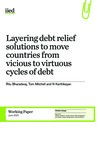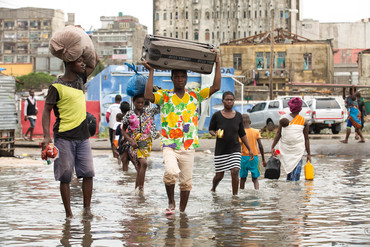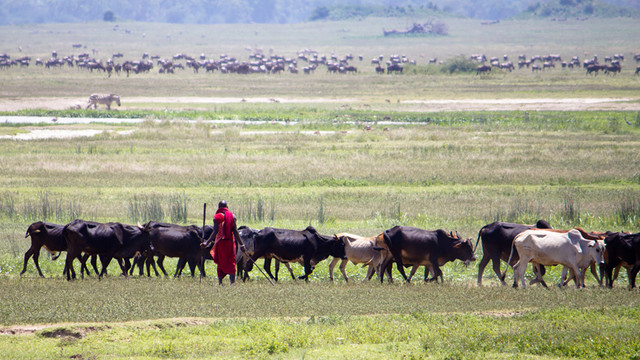We need a new, layered approach to debt relief and climate financing
Adopting a layered approach to debt relief and climate financing can offer least developed countries and Small Island Developing States the comprehensive support they need to respond to the impacts of climate change and break free from vicious cycles of debt.



Aftermath of cyclone Idai in Mozambique, 2019. Responding to disasters increases countries' debt (Photo: Denis Onyodi/IFRC/DRK/Climate Centre, via Flickr, CC BY-NC 2.0)
As climate change wreaks havoc worldwide, leading to more frequent and severe disasters and biodiversity loss, the burden falls heavily on least developed countries (LDCs) and Small Island Developing States (SIDS). Each time disaster strikes, they accumulate additional debt to provide urgent relief, restore normalcy and rebuild their economies. This perpetuates an unsustainable debt cycle that hampers their ability to tackle future crises.
A layered approach to debt relief could enable a transition to a more virtuous debt cycle.
Consequences of climate-induced debt
As extreme weather events intensify and recur, LDCs and SIDS are increasingly vulnerable. Response efforts may increase their debt (see the graph below), which they then need to service, eroding their capacity to handle subsequent crises. The COVID-19 pandemic and war in Ukraine have further compounded their debt burden, exacerbating their financial challenges.
Major disasters affect countries’ external debt profiles

Graph showing how major disasters affect countries’ external debt profiles using the examples of Mozambique, Ethiopia and Nepal (Graph: IIED)
A global injustice
LDCs and SIDS are most affected by, and least responsible for, climate change, which is trapping them in deeper debt crises. To rectify this inequity, they need debt relief based on the principles of climate justice in three key areas:
- Immediate relief operations: debt relief can facilitate vital operations to save lives, launch rescue operations, prevent further harm and restore essential services after a disaster.
- Short- to medium-term recovery: new and additional aid or concessional finance can support prompt recovery, restoring livelihoods and restarting economic activities after a disaster.
- Long-term adaptation: predictable, grant or highly concessional funding for climate-resilient infrastructure and livelihoods will help LDCs and SIDS minimise or avoid future climate impacts.
Tools for managing debt and climate finance
Short of universal debt cancellation for LDCs and SIDS, single debt relief measures alone cannot restore solvency effectively.
To address unsustainable debt, countries need a combination of measures that offer substantial relief and cover recovery needs across the short, medium and long terms. Layering climate finance support will give them the tools they need to safeguard against future climate impacts.
A multilayered approach to debt relief

A chart showing the various options of a multilayered approach to debt relief (Chart: IIED)
Immediate rescue and relief
Including a pause clause in sovereign debt allows countries to temporarily suspend repayments, providing immediate relief and freeing up financial resources for post-disaster emergency response. Parametric insurance can offer quick payouts for debt repayment based on predetermined triggers, enabling countries to reallocate budgets to recovery and response efforts.
Short- to medium-term recovery
Extending repayment terms, reducing interest rates and other forms of debt reprofiling can alleviate debt burdens in the medium term. And combining this with a debt swap – exchanging a portion of debt for investments in climate resilience and nature restoration projects – would provide additional funding and align debt restructuring with climate and biodiversity goals.
Long-term resilience building
Resilience bonds can attract investment to climate resilience projects and initiatives, securing long-term financing to support climate adaptation, infrastructure development and disaster risk reduction. Access to climate finance for adaptation, loss and damage, and to promote low-carbon growth is also crucial.
The chart below shows how combining or layering different instruments builds countries’ resilience to debt default. In Mozambique, Ethiopia and Nepal, layering all five instruments described above allows them to cover risks altogether.
Graph showing how combining or layering different instruments builds countries’ resilience to debt default (Graph: IIED)
Benefits of layering debt relief and climate financing options
Combining debt relief and climate finance measures can improve countries’ ability to cope during and after disasters. The layered approach offers several advantages.
First, as each measure addresses a specific risk – for example, economic recession, disruption of basic services, unfavourable repayment terms – combining them improves risk management.
Second, it offers more financial flexibility, enabling countries to optimise resources, manage debt effectively and allocate funds for recovery and resilience.
Third, it offers tailored solutions. As relief measures serve a specific purpose, countries can combine them to design a strategy that meets its needs.
Finally, layering gives countries access to diverse finance sources beyond traditional borrowing, such as insurance and resilience bonds, strengthening their financial framework and allowing them to address climate-related challenges.
Considerations for effective debt management
To design an effective model for layering debt relief options, countries, donors and creditors should:
- Consider climate disasters impacts, debt-to-GDP ratio and revenue generation to evaluate the country’s ability to repay debt and ensure the debt is sustainable
- Adopt a fairer approach to credit rating so country’s borrowing rate doesn’t increase because of exposure to climate impacts
- Ensure access to comprehensive legal assistance, in line with those of creditors, to safeguard rights and enable informed decision-making in complex debt restructuring processes
- Assess the costs, savings and overall impact of debt on the national financial situation to understand the implications of debt
- Explore alternative sources of finance, such as climate funds and humanitarian assistance
- Choose options that align with national climate strategies and development goals, to promote sustainable development and build resilience
- Ensure measures adopted do not result in countries paying back more due to currency fluctuations
- Involve all stakeholders in the process for transparency and effectiveness, and
- Strengthen institutional capacity and coordination for successful implementation.
While innovative debt relief measures offer certain advantages, they only address a fraction of post-disaster financing needs. A layered approach that combines debt relief and climate financing options will provide comprehensive support to LDCs and SIDS.
The Global Financing Pact agenda and the United Nations Framework Convention on Climate Change’s commitment to create a Loss and Damage Fund present opportunities to develop such a solution.
IIED urges the International Monetary Fund, World Bank, creditor governments, private sector creditors and the Paris Club to adopt this agenda, foster collaboration among stakeholders and provide a complete debt relief and financing package to address climate change impacts, promote resilience and support sustainable development in climate-vulnerable nations facing sovereign debt crises.





